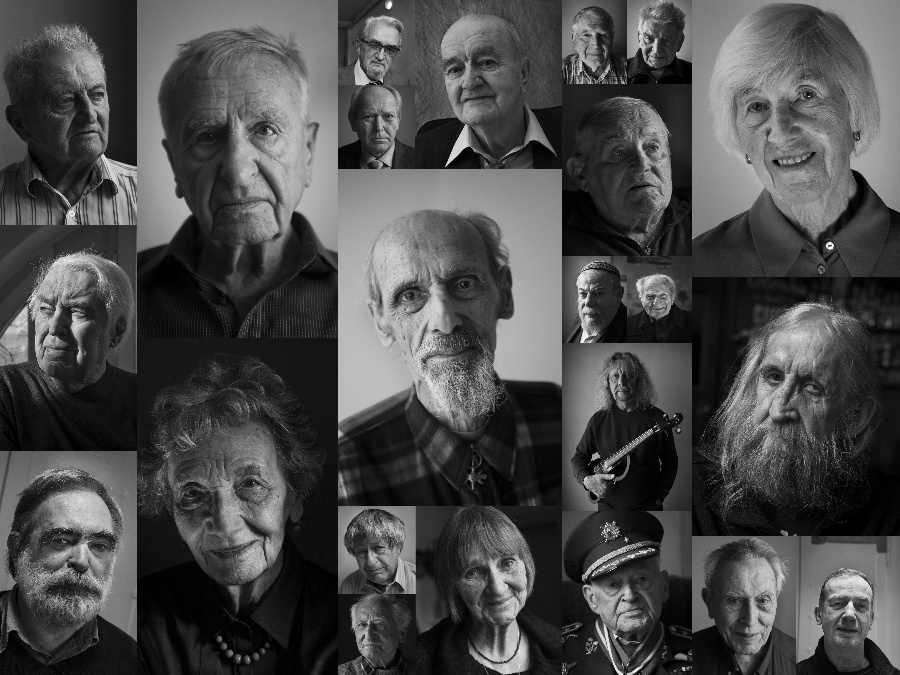Foreword
- See the exhibition
- Read the whole text (PDF, 0 kB)

Exhibitions or collections of photographic portraits do not as a rule require written explanations. The pictures speak for themselves, their stories told by the manner in which the photographer has captured his or her “models”, the environment in which they have been placed and their facial expressions. An introduction is, however, necessary in the case of Pavel Hroch’s project Fifty faces of resistances. It presents people who over a span of many decades stood up to evil, inhumanity, repression, brutality and barbarism, who in certain moments displayed courage, a will to freedom, a love of their fellow man and common sense. That is what connects them.
In the 20th century Czech society lived through two totalitarian regimes, Nazism and Soviet-style communism. Its transformation was so radical that even many Czech intellectuals do not fully understand it. Explaining such a thing to foreign observers is all the harder. Until 1938 Czechs, Slovaks, Germans, Jews and people of other nationalities were still living in the then democratic Czechoslovakia. The Nazi occupation of the Czech lands in 1939–1945 was a bombshell with multiple effects: the collapse of the state (the Slovaks declared independence), the elimination of a sizable section of the elites, mass deportations, the murder and robbery of almost the entire Jewish and Romany populations and the annihilation of the rule of law and the consciousness of law. Resistance and opposition to Nazism took numerous forms: some fought on the Western or Eastern fronts, others were active in the underground at home and still others tried to resist in appalling conditions in ghettos or death camps by maintaining their dignity and sense of values, looking after their children and demonstrating their moral superiority to their tormentors.
Following liberation and the renewal of Czechoslovakia, domestic politicians, already subordinate to the Soviet Union, decided to drive over two million long-term German inhabitants out of the country. They too lost virtually all their property, which people “took over”; the decline of law and trend of violence continued as diversity gave way to ethnic uniformity. In February 1948 the Communist Party of Czechoslovakia staged a coup, which was again followed by the utter abolition of civil rights, the elimination of the remaining intellectuals and greats of the arts world, entrepreneurs, the self-employed, farmers and the church. In other words, another decline in diversity, which was replaced by terror, mass emigration and wholesale robbery. The country was surrounded by barbed wire, isolated from the West and transformed into a huge concentration camp. Standing up to communism was to a certain degree harder than fighting the Nazi occupiers: society was divided on ideological lines, while for several reasons the resistance could not count on a unified leadership. Despite this, people withstood as best they could, in the circumstances. They attempted armed resistance, worked with the secret services of democratic countries, maintained their religious lives, ferried what was needed across the border, stood up to forced collectivisation, went into exile and served their homeland. Thousands ended up in secret police torture cells, in prison and in labour camps. The power imbalance was such that victory was impossible.
Thought it went through alternate phases, sometimes turning more hard-line, sometimes festering, the Communist regime was undemocratic throughout its existence. In August 1968 those who had set it up 20 years previously made an effort to humanise it. After a brief period of reform and political liberalisation, the Soviet Army occupied Czechoslovakia, remaining in the country for two decades. A fresh wave of purges and escapes followed in the so-called normalisation period (1969– 1989), in which a collaborationist apparatus, taking its lead from the 1950s, permitted no civic freedoms until the system collapsed in November 1989. In this period also there was civic resistance, demonstrated by writers and musicians, who refused to accept the dictated requirements, signatories of Charter 77 and other anti-totalitarian initiatives, samizdat publishers, members of the Committee for the Defence of the Unjustly Persecuted, organisers or apartment seminars and refugees who were not deterred from the journey to freedom by either barbed wire or armed guards. It was as if the complicated nature of Czech history in the 20 h century came to a head in the normalisation-era opposition: working alongside each other were Communists from the 1950s, cured of that ideology and otherwise, and, for instance, Catholics who had spent that era in prison.
The Czech 20 th century was long and cruel and to this day society hasn’t gotten over it. Each of the people whose portrait Pavel Hroch has created in this series succeeded in the years 1938/1939–1989 in standing up to evil, in risking their lives, in placing justice and civilisation ahead of their own peace and comfort. Each belongs to a minority whose work contributed to a good tradition, to the fact that we have something to build on today.
Text by Adam Drda